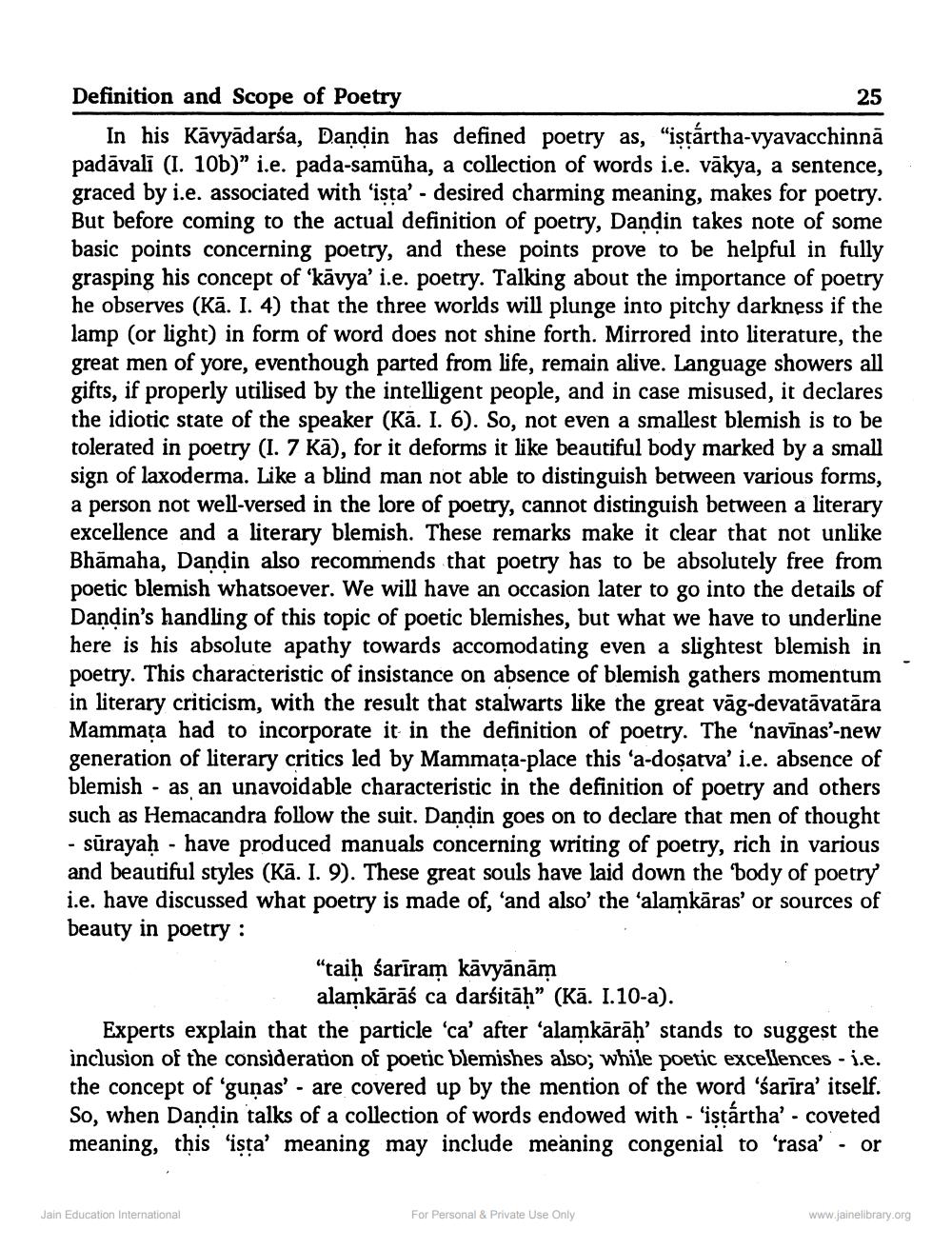________________
Definition and Scope of Poetry
25 In his Kāvyādarśa, Dandin has defined poetry as, “istártha-vyavacchinnā padāvali (I. 10b)” i.e. pada-samūha, a collection of words i.e. vākya, a sentence, graced by i.e. associated with 'ista' - desired charming meaning, makes for poetry. But before coming to the actual definition of poetry, Dandin takes note of some basic points concerning poetry, and these points prove to be helpful in fully grasping his concept of ‘kāvya' i.e. poetry. Talking about the importance of poetry he observes (Kā. I. 4) that the three worlds will plunge into pitchy darkness if the lamp (or light) in form of word does not shine forth. Mirrored into literature, the great men of yore, eventhough parted from life, remain alive. Language showers all gifts, if properly utilised by the intelligent people, and in case misused, it declares the idiotic state of the speaker (Kā. I. 6). So, not even a smallest blemish is to be tolerated in poetry (I. 7 Kā), for it deforms it like beautiful body marked by a small sign of laxoderma. Like a blind man not able to distinguish between various forms, a person not well-versed in the lore of poetry, cannot distinguish between a literary excellence and a literary blemish. These remarks make it clear that not unlike Bhāmaha, Dandin also recommends that poetry has to be absolutely free from poetic blemish whatsoever. We will have an occasion later to go into the details of Dandin's handling of this topic of poetic blemishes, but what we have to underline here is his absolute apathy towards accomodating even a slightest blemish in poetry. This characteristic of insistance on absence of blemish gathers momentum in literary criticism, with the result that stalwarts like the great väg-devatāvatāra Mammata had to incorporate it in the definition of poetry. The 'navīnas'-new generation of literary critics led by Mammata-place this 'a-dosatva' i.e. absence of blemish - as an unavoidable characteristic in the definition of poetry and others such as Hemacandra follow the suit. Dandin goes on to declare that men of thought - sūrayaḥ - have produced manuals concerning writing of poetry, rich in various and beautiful styles (Kā. I. 9). These great souls have laid down the body of poetry i.e. have discussed what poetry is made of, and also the 'alamkāras' or sources of beauty in poetry :
"taiḥ śariram kävyānām
alamkārāś ca darsitāḥ" (Kā. I. 10-a). Experts explain that the particle 'ca' after 'alamkārāḥ' stands to suggest the inclusion of the consideration of poetic blemishes also; while poetic excellences - i.e. the concept of 'gunas' - are covered up by the mention of the word 'śarīra' itself. So, when Dandin talks of a collection of words endowed with - 'iştártha' - coveted meaning, this ‘ista' meaning may include meaning congenial to 'rasa' - or
Jain Education International
For Personal & Private Use Only
www.jainelibrary.org




